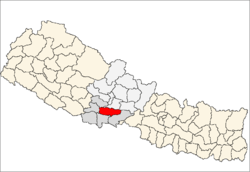Darlamdanda
| Darlamdanda दर्लमडाँडा | |
|---|---|
| Village development committee | |
 Darlamdanda Location in Nepal | |
| Coordinates: 27°55′N 83°37′E / 27.91°N 83.61°ECoordinates: 27°55′N 83°37′E / 27.91°N 83.61°E | |
| Country |
|
| Zone | Lumbini Zone |
| District | Palpa District |
| Population (2011) | |
| • Total | 2,097 |
| Time zone | Nepal Time (UTC+5:45) |
Darlamdanda is a village development committee in Palpa District in the Lumbini Zone of southern Nepal. At the time of the 2011 Nepal census it had a population of 2097 people living in 519 individual households.[1]
This VDC shares its borders with Khanichhap VDC in the east, Nayar Namtalesh and Chappani VDCs in the south, Yamgha VDC in the west, and Syangja district on the north. The holy place Ramdi on the bank of Kali Gandaki river is located in this VDC. The famous and unique Ramdi-pul (bridge) in the Palpa Syangja section of Siddarath Highway is located here. There are special occasions like haribodhani ekadashi (also called Kattike Thuliekadashi), baishakhe sakranti (Nepali new year) that people from neighbouring VDCs and districts visit here.
Darlamdanda Higher Secondary School is one of the major educational institutions in the area. It was established in 2013 BS (Bikram Sambat) as a primary school. It has been upgraded to higher levels in different steps and now classes run up to 12th grade. This school has a huge impact on the educational life of the people in the remote north of the district headquarters. Another school in this area is Sarswati Lower Secondary School which runs upto 8th grade is in Garandanda, ward no. 7 of this VDC.
Darlam Mahakali Temple is one of the famous hindu temple in this area where goddess Mahakali is worshiped. This temple is located at Darlam Danda VDC-1, Darlam Danda Palpa, Nepal. At this place, the ancestors of late Padampani Gaire had been worshiping Shree Mahakali Bhagwati for several years. In 2000BS, late Padampani Gaire established small temple and worshiped a statue of Mahakali made of clay every day. On 2010BS, Kartik shukla triyodashi, Shree Mahakali appeared in his dreams and said him that she would appear as a stone at a particular time and place. She wanted him to bring that stone and start worshiping her instead of the clay statue. Surprisingly, Mr Humakanta Bashyal, an astrologist had the same dreams on the same night. Both of them went to search the stone according to instructions of goddess independently and found the holy stone at Sapangdi , approximately 200 feet east of the present temple. The holy stone was approximately five feet tall. Since then, this holy stone is worshiped as Shree Darlam Mahakali Bhagwati established in the temple and worships, punchayan puja and rudravishek hawan have been offering to Darlam Mahakali every day. A new temple is being built at the same place now.
The new temple is being built based on the instructions of Shree Darlam Mahakali given to Mr Ganraj Gaire, son of late Padampani Gaire on 2048BS Kartik 22nd in his dreams. The structure of temple is similar to the Manakamana temple as per Shree Mahakali Bhagwati instructions. This temple is built on the land donated by Gaire families, the descendents of late Padampani Gaire and is now made public property where everyone can worship every day. The structure of this new temple is based on pagoda architecture. The main construction was started on the auspicious day of 2053BS Ashwin Mahanawami. The master plan of this development is to built Shree Ganesh Temple, Shree Bhagawati Panchayan Temple, Shree Shive Temple, Shree Laxmi Narayan Temple, Yagya Mandap, Hawan Kunda, Ved Vidyapeeth and Vandar Kashya around the main temple. To complete this master plan, develop this area as a holy place and keep sacred importance of this temple, Shree Darlam Mahakali Bhagwati temple development and management committee has been established on 24th Bhadra 2057BS. This committee has 17 members representing five VDC of nearby villages. It is registered in district administration office Palpa.
The climate in the area is very nice all yeararound. The snowfall is a rare case almost no record so far. It rains heavily in the summer. There is no irrigation facility so farmers have to depend on the rain (monsoon). The climate is very friendly to grow variety of fruits, vegetables, and grains.
This place was also known for the Sani Ukali (short but steeper climbings) on the way from Ramdi to Tansen and the Thuli Ukali (big one) in the neighbouring Chappani VDC. There was a project,around 1991 AD (2047 BS) to improve this historical trekking road from Ramdi to Tansen and some section of this was upgraded nicely. However, the work was not completed. After few years, another project started to provide a roadway from Tansen to Ramdi. This included a very hard work of the local people. By 2008 AD (2065 BS) the first phase of it was completed. Except for heavily raining seasons, there is a transportation service available from Butwal and Tansen to Darlamdanda and neighbouring village development committees.
In Nepali, the name of this place is दर्लमडाँडा (and not the दर्लामडाँडा as it sounds so from the spelling DARLAMDANDA). The ward number one of Darlamdanda VDC also has the same name Darlamdanda. There is a tale\story why the name is darlamdanda, many years ago there were people living with their last name Darlami and geographically the place is a hill/mountain (with meaning डांडा in Nepali language). With this combination the place is now known as दर्लमडाँडा. However, majority of the people living in Darlamdanda today have a very different last name (Gaire) compared to the historic last name (Darlami).
The population of the Darlamdanda VDC is very diverse. This obviously has impact on the social, cultural, educational, and economical life of the people living there.
References
- ↑ "Nepal Census 2001". Nepal's Village Development Committees. Digital Himalaya. Retrieved 12 December 2008.
